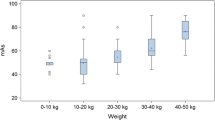Abstract
Thin-section, high-resolution (1.0/1.5 mm thick slices), low-dose chest CT scans were performed in 55 infants and children. The studies were carried out with 1-and 2-s scan (data acquisition) times using a high-resolution (bone) algorithm. Although there was some motion artifact, the studies provided valuable information for evaluating diffuse parenchymal lung disease. The thin slices provided finer detail and more diagnostic information than images representing thicker sections. Most studies were performed using between 40 and 80 mAs. It is estimated that the patients' radiation exposure was 20% that of conventional high-resolution CT (HRCT) and 57% that of routine chest CT. Diagnostic HRCT scans can be obtained in infants and young children without the need for suspended respiration or specialized ultrafast CT scanners.
Similar content being viewed by others
References
Webb W, Stein M, Finkbeiner W, Im J, Lynch D, Gamsu G (1988) Normal and diseased isolated lungs: high-resolution CT. Radiology 166: 81–87
Murata K, Khan A, Rojas K, Herman P (1988) Optimization of computed tomography technique to demonstrate the fine structure of the lung. Invest Radiol 23: 170–175
Kuhn J (1993) High-resolution computed tomography of pediatric pulmonary parenchymal disorders. Radiol Clin North Am 31: 533–551
Zwirewich C, Mayo J, Muller N (1991) Low-dose high-resolution CT of lung parenchyma. Radiology 180: 413–417
Naidich D, Marshall C, Gribbon C, Arams R, McCauley D (1990) Low-dose CT of the lungs: preliminary observations. Radiology 175: 729–731
Mayo J, Jackson S, Muller N (1993) High-resolution CT of the chest: radiation dose. AJR 160: 479–481
Fearon T, Vucich J (1985) Pediatric patient exposures from CT examinations: GE CT/T9800 scanner. AJR 144: 805–809
Rothenberg L, Pentlow K (1992) Radiation dose in CT. Radiographics 12: 1225–1243
Galvin J, Mori M, Standord W (1992) High-resolution computed tomography and diffuse lung disease. Curr Probl Diag Radiol 21: 31–74
Lynch D, Brasch R, Hardy K, Webb W (1990) Pediatric pulmonary disease: assessment with high-resolution ultrafast CT. Radiology 176: 243–248
Agostini C, Trentin L, Zambello R, Semenzato G (1993) HIV-1 and the lung, infectivity, pathogenic mechanisms, and cellular immune responses taking place in the lower respiratory tract. Am Rev Respir Dis 147: 1038–1049
Brody A, Kuhn J, Seidel F, Brodsky L (1991) Airway evaluation in children with use of ultrafast CT: pitfalls and recommendations. Radiology 178: 181–184
Brasch B (1988) Ultrafast computed tomography for infants and children. Radiol Clin North Am 23: 613–626
Stern E, Webb R, Warnock M, Salmon C (1991) Bronchopulmonary sequestration: dynamic, ultrafast, high-resolution CT evidence of air trapping. AJR 157: 947–949
Author information
Authors and Affiliations
Rights and permissions
About this article
Cite this article
Ambrosino, M.M., Genieser, N.B., Roche, K.J. et al. Feasibility of high-resolution, low-dose chest CT in evaluating the pediatric chest. Pediatr Radiol 24, 6–10 (1994). https://doi.org/10.1007/BF02017649
Received:
Accepted:
Issue Date:
DOI: https://doi.org/10.1007/BF02017649




